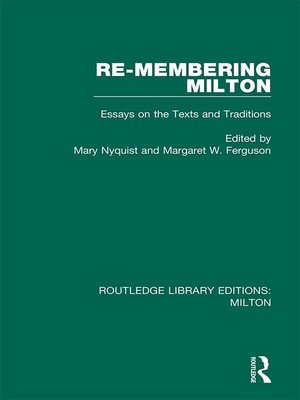Re-membering Milton
ebook ∣ Essays on the Texts and Traditions · Routledge Library Editions: Milton
By Mary Nyquist

Sign up to save your library
With an OverDrive account, you can save your favorite libraries for at-a-glance information about availability. Find out more about OverDrive accounts.
Find this title in Libby, the library reading app by OverDrive.



Search for a digital library with this title
Title found at these libraries:
| Library Name | Distance |
|---|---|
| Loading... |
First published in 1987. Passionately praised and equally passionately criticised by contemporary and later writers, the figure of Milton inherited by the twentieth century is by no means unified, despite the appearance of monumental unity his work sometimes acquires in the classroom and in academic criticism.
This collection of essays gathers together disparate and often conflicting representations of Milton as author and cultural figure. Critics familiar with the traditions of Milton scholarship and with debates in literary theory reconstruct Milton from evidence provided by his own prose and poetry, by his contemporaries (including some little-known women writers), by Romantics such as Blake and Wordsworth, and, finally, by a tradition of Afro-American writing that reflects Milton's influence in ways previously unexamined by critics. The process of reconstruction can also be seen as a process of "re-membering." The volume draws inspiration from, but also interrogates, the figure used in Areopagita to describe the quest for truth. Likening Truth to the dismembered body of Osiris, Milton urges Truth's friends to seek up and down, gathering "limb by limb" the body scattered through time and space.
Re-membering Milton includes work by established critics from both sides of the Atlantic. Together these contributors place Milton and different Milton traditions firmly within the arenas of modem critical debate. As a result, the collection will be of interest to a wide range of readers: scholars concerned with Milton and Renaissance literature and history; advanced undergraduates and graduate students; researchers in women's studies; and all readers generally concerned with trends in literary and cultural theory.







